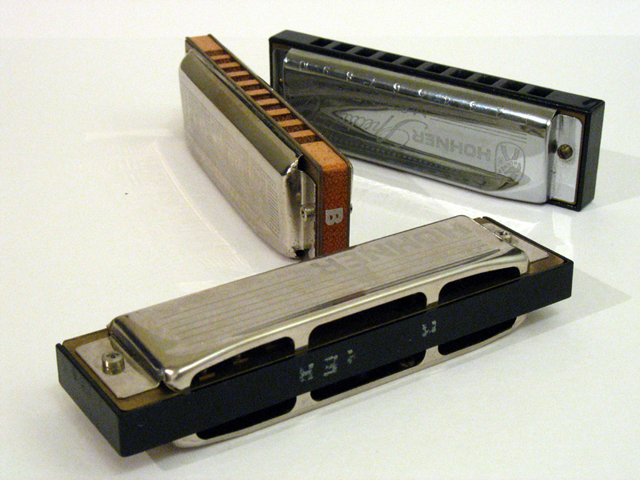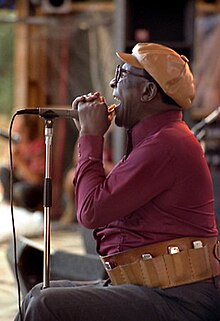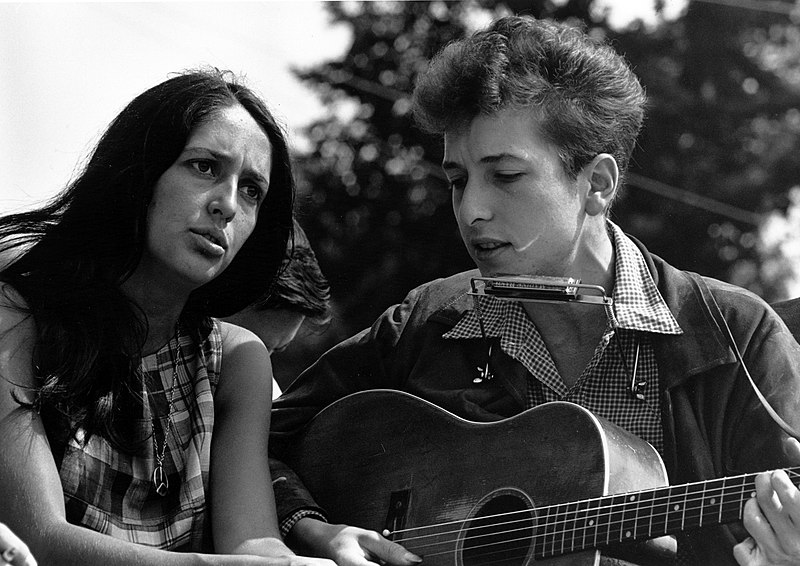I started learning harmonica in high school. It was the first instrument I learned voluntarily, not counting my ineffectual middle school attempt at classical cello. As a teenager, my obsession with the Grateful Dead was at its high water mark. The Dead’s first frontman, Ron “Pigpen” McKernan, was a more than respectable blues harmonica player. Through the Dead, I got exposed to all the blues and country greats. I forget exactly how and why I started playing harmonica myself, but it’s probably because it was inexpensive and looked easy. I started with Country And Blues Harmonica For The Musically Hopeless by Jon Gindick, which I enthusiastically recommend.
Meet the harmonica
The harmonica was invented in Germany in the early 1800s, probably inspired by the east Asian sheng. There are many varieties, but the most familiar one here in America is the ten-hole diatonic model. It’s designed so that it only plays the notes within a particular major scale. When you blow in the holes, you get a major chord arpeggiated through three octaves. You can also suck air through the holes to get a dominant ninth chord. Harmonica is the only instrument I know of that you play by inhaling.
You need to have a different harmonica for each key you want to play in. I have at least one for each of the twelve keys, but you can get along pretty well with just C, G, D and A. My preferred brand is the Hohner Special 20, which sounds great out of the box and lasts for basically ever, as long as you clean it out once in a while. I’ve also tried out the Hohner Golden Melody, which has a more delicate sound and gives finer pitch control, but is more expensive. The Hohner Marine Band sounds good too, but I find it a little harder to control, and it gets pretty repulsive after it’s been in your mouth a thousand times.
The notes
Here are the notes you can play on a C harp. The top row shows the C major triads you get from blowing, and the bottom row shows the G9 chord you get from drawing.
By blowing and drawing on the C harp, it’s very easy to figure out certain major-key folk tunes. “Oh Susanna” is the canonical beginner harmonica song. You can also play Brahms’ Lullaby, and even (if you’re very enterprising) Bach’s “Jesu, Joy Of Man’s Desiring.”
Effortless though it is to play I and V7 chords on the harp, you quickly run into its limitations. Playing the major scale in sequence is a challenge because of the idiosyncratic arrangement of the notes across the holes. Also, you can’t really play the IV chord (F major in the key of C.) You can fudge it by drawing holes 5 and 6, but that isn’t the full chord, and it feels unsatisfying.
You’re likely to experience even more frustration if you want to play blues, or rock, or many flavors of country, or really anything else descended from the African-American tradition, since the plain-vanilla major scale just does not have the notes you want. To get that blues sound, you need to play in a style called cross harp.
Cross harp and the blues
In cross harp, you play a harmonica tuned to a different key than the one the song is in. This gives you a spicier collection of notes to work with than in straight harp. Cross harp is a much better fit for blues tonality.
Take a look at this diagram of the twelve keys in Western music. It’s called the circle of fifths because the keys are arranged a fifth apart as you go around clockwise.
To play cross harp, find out what key the song is in, and use the harp from the next key counterclockwise. For a song in E, use an A harp. For a song in A, use a D harp. For a song in D, use a G harp. For a song in G, use a C harp. And so on.
Let’s take another look at the notes in a C harp, this time from the perspective of G blues.
In cross harp, you’re mostly drawing, which gives you the I7 (G7) chord. In scale form, this chord is known as the Mixolydian mode. Mixolydian has the flat seventh from the blues scale. By leaning on this note (5 draw) and the notes surrounding it, you get the classic “train chord” that forms the foundation of blues harp. By bending or flattening B (3 draw) and D (4 draw), you get the other blues scale notes — more on this technique below.
When you blow in cross harp, you get the IV (C) chord. You can’t play the V7 (D7) directly, but you can fudge it in a couple of interesting ways. If you play on the bottom two holes, you get D7sus4, and if you draw on holes 4, 5 and 6, you imply D7#9, which sounds extremely hip. You can also play the blues scale over any chord, it’s a universal harmonic solvent.
Bending and microtones
By far the hardest aspect of playing harmonica is learning how to bend notes so they go intentionally flat. This technique of playing between the piano-key pitches is essential to soulful blues (and rock, and country, etc.) Here’s a handy video explanation of bending.
https://www.youtube.com/watch?v=tbZibBnusLQ
Bending takes a lot of practice. You’ll try and try and try, and it won’t happen. Then a few weeks later, you pick up the harp and find that you can suddenly bend effortlessly. Hang in there.
Minor keys
Harmonica does not get along well with minor keys, sad to say. It’s easy to play Dorian mode if you use a harp tuned a whole step below the key of the song. But not that many songs are solely in Dorian, and the natural sixth clashes horribly with natural or harmonic minor. If you want to play either of those scales, you can either carefully avoid the sixth, or try to bend it down to flat six. Either way, it’s awkward at best. You can buy special harmonicas tuned to natural and harmonic minor scales, but that’s a pain too.
Who to listen to
DeFord Bailey was the first black performer on the Grand Ole Opry and played beautiful unaccompanied solo harp. He was also a snappy dresser.
Little Walter Jacobs played on most of the classic Muddy Waters recordings, as well as his own solo albums. He famously played harp through a cranked-up guitar amp to get a sound resembling distorted saxophone, which has been much imitated since. He also basically wrote the book on wailing blues feel.
Here’s Little Walter with Muddy Waters:
Sonny Terry played incredibly uninhibited and energetic blues harp, punctuated by his yelping and hollering.
My favorite straight harp player is Bob Dylan, who brings the same wailing intensity to plain-vanilla major-key folk as the people above do to cross harp. Like any good sixties folkie, Bob plays harmonica in a neck-mounted holder, so he can play guitar at the same time.
I need to mention Howard Levy, just for his staggering virtuosity. Howard bends notes with such precision that he can get any exotic scale he wants out of a regular diatonic harmonica. You can hear him with Béla Fleck and the Flecktones and many other equally geeky bands.
And what about Stevie Wonder, you may be asking? Isn’t he one of the greatest harmonica players of all time? He is indeed, but Stevie plays a different instrument, the chromatic harmonica. This is a bigger and more complex contraption with a thumb-activated slider that lets you access all the notes on the piano.
Chromatic harp is so difficult that it seems like it would make more sense to just play the saxophone or something. Stevie makes chromatic harp wail, but few of us have the discipline to practice as much as Stevie does.
The best harmonica player in the world of straight-ahead jazz is Toots Thielemans, who plays full-blown bebop on chromatic harp. Toots has also written some landmark tunes, most famously “Bluesette.”
Future harp
Harmonica is inevitably associated with old-timey music, but I’ve found it works great over abstract electronica too. When I play techno music, I sometimes play harp through my guitar multi-FX unit. Guitar distortion works well on harp, as Little Walter figured out back in the fifties. Delay is another really good harp effect. Set it to a long decay time and hold out some long bent notes. Trippy! I also like the sound of phaser, tremolo, harmonizer and ring modulator. I haven’t tried out a loop player with harp yet, but that seems like the next logical step.
Here’s a performance I did at a Disquiet Junto concert playing harp through Ableton Live over some experimental electronic music I composed.
Learning to play
Harmonica is mostly about feeling, tone, rhythm and phrasing. It’s hard to explain verbally. I recommend getting a good teacher, at least when you’re getting started — if you’re in or around New York City, get in touch with me. YouTube is a great resource too. The best resource is recordings. Start with Little Walter and work your way out. Practice often, and have fun.










Hi,
I came across your site replying to a couple of Quora Harmonica questions.
Nice thesis! Have you seen Sentris? A circular music game along simlar conceptual lines. http://timbreinteractive.squarespace.com/#home-about
re: Harmonica
You might also want to check out HarpNinja http://www.harpninja.com/ , which I developed to help people learn harp faster (myself in the first instance) by closing the visualisation learning loop.
Cheers,
Paul